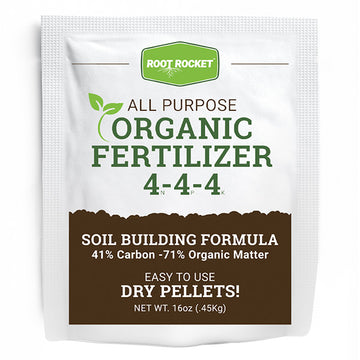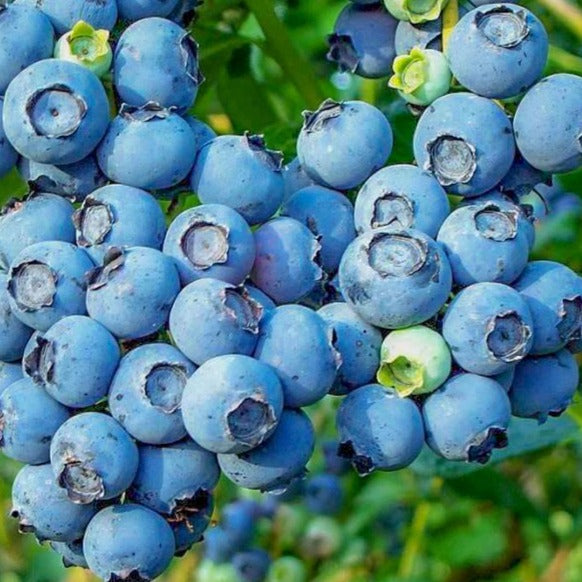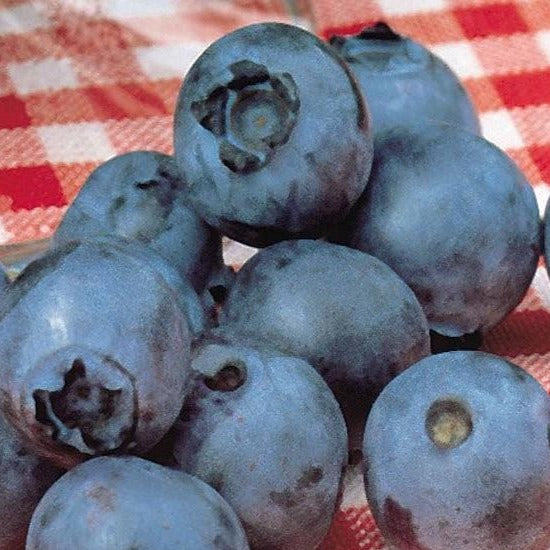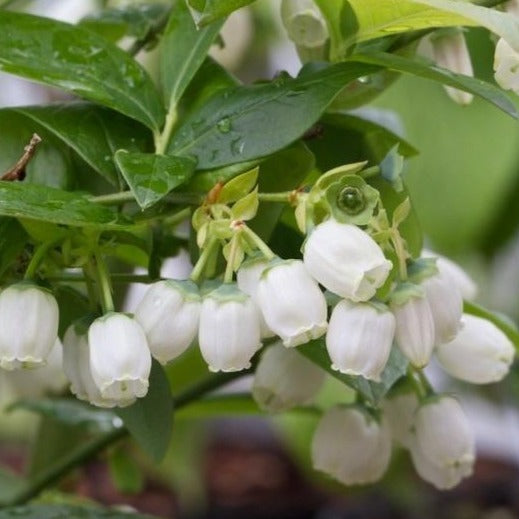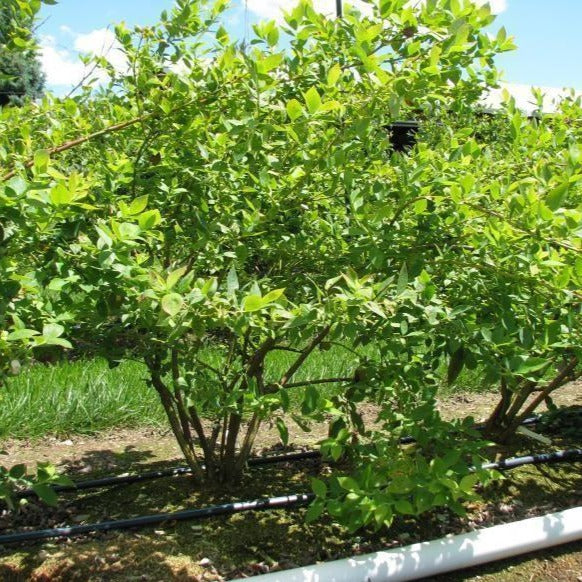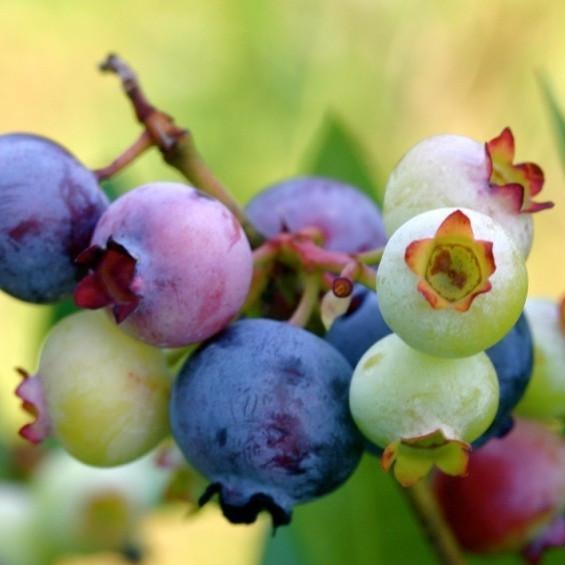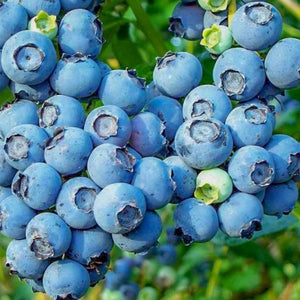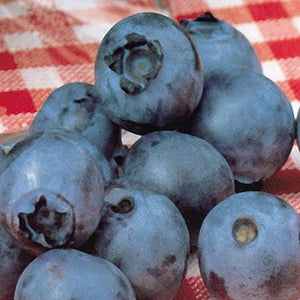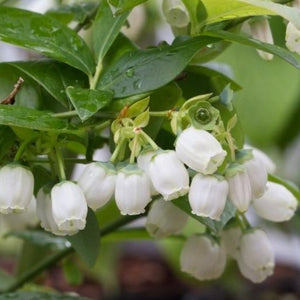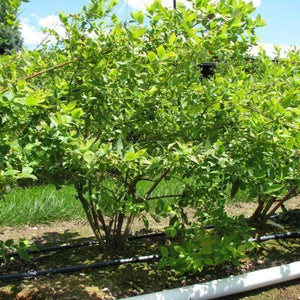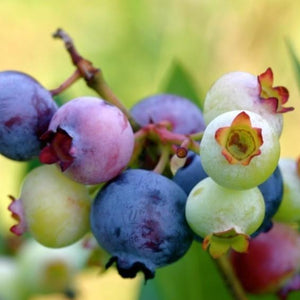Powder Blue Blueberry
Product Details
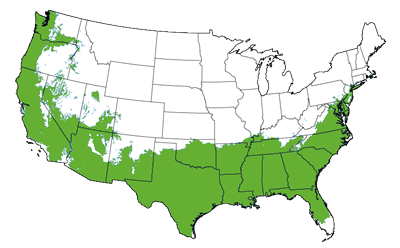 Growing Zones 7-9
Growing Zones 7-9
| Soil Type | Acidic |
| Sunlight | Full, Partial |
| Drought Tolerance | Good |
| Mature Height | 6-10 Feet |
| Mature Width | 6-10 Feet |
| Fall Color | Red |
| Bloom Color | White |
| Shipping Restriction | AK, AZ, CA, GA, HI, OR, WA |
The Powderblue Blueberry bush is a Rabbiteye variety. Rabbiteye blueberry bushes are well suited to grow in the Southeastern US due to their vigorous growing habits and ability to withstand heat. This type of blueberry bush is easy to grow due to their low maintenance requirements and few pest issues.

Features
The Powderblue Blueberry gets its name from the powder blue blush that the berries gain upon ripening. It is actually one of the toughest blueberry plants with a late ripening season. The Powderblue blueberry bush has an upright growing habit that can reach a height and width of 8-12 feet. Blooms form in late spring with a harvest in late summer. The blueberries are medium sized, firm, and packed with juicy, sweet flavor.
Blueberry Comparison Chart - Self-Fertile
Blueberry Comparison Chart - Not Self-Fertile
The Importance of Blueberry Plant Pollination
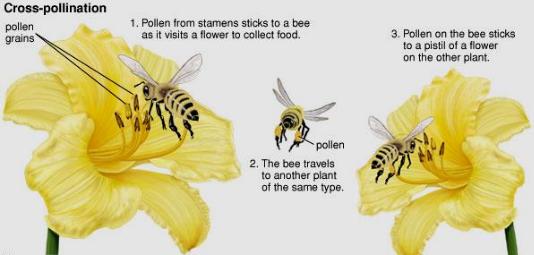
Southern Highbush plants are self-fertilizing, however Rabbiteye plants need a second plant in order to pollinate and produce fruit. Even if a blueberry bush is self-pollinating, a second bush will benefit both plants for a larger fruit production through cross-pollination. Cross-pollination refers to the spreading of pollen from one plant variety to another variety of the same species.
Blueberry bushes produce thousands of flowers every year, with each one having the potential to be a blueberry. In order for a blueberry plant to set fruit, the pollen produced by the flower’s anthers must reach the stigma. This will then cause a seed to develop inside the flower’s ovary. Because pollen is very sticky and heavy, it is not able to be easily moved and carried around by the wind.
Blueberry plants require acidic soil to grow and produce fruit. These plants will not perform well if the soil PH is above 5.5. If you are unsure about your soil’s PH level, it can be tested. You can either test the PH level of your soil with an at home PH level testing kit or reach out to your Local County Extension Service for a soil test at little to no cost. If the PH level of your soil is too high, it will need to be lowered. It can be lowered by adding granular sulfur to the soil. Till the sulfur into the soil about 3 months before you plan on planting your bush.
If you would rather use a chemical-free approach, use coffee grounds or acidic peat moss. To ensure that the acidic level of the soil is maintained around your blueberry bush, add peat moss, pine needles, and/or coffee grounds around the plant once a year.
Along with acidity, these plants also like well-drained soil. To test how well your soil will drain, dig a hole and fill it with water. If the hole is drained within a couple of hours, you have good soil drainage. If the water is still remaining in the hole after 24 hours, you have poor soil drainage. To help the soil drain better, sand can be tilled into the soil or a raised bed can be created.
Blueberry plants require full sun for optimum production. They will survive in partial sun, but only when shade is provided early in the morning or late in the day. 7-8 hours minimum amount of sunlight is recommended for a healthy blueberry bush.
Blueberry bushes look great when added to the landscaping. They not only produce enjoyable treats, but they provide multi seasonal interests. These shrubs display pretty bell-shaped flowers in the spring and a full crown of green foliage in the summer.
Early to late summer, you can expect ripening fruit ready for harvest and fall gracefully turns the green foliage to pinks, reds, yellows, and oranges. Blueberry bushes drop their leaves in the winter, adding additional sunlight peeping through the branches and providing a great window for pruning opportunities.
Blueberry bushes are easy to maintain, but do have specific requirements. If your native soil is naturally acidic, great! That means less soil maintenance. If not, soil PH levels will need to maintained at an acidic state. If you are planting your blueberry bushes directly into the soil, they will look great as hedges or even planted as lone specimens.
Plant blueberry bushes 6 foot apart in rows for a beautiful fruit bearing hedge. Always remember to plant 2 or more blueberry bushes to allow for cross-pollination. If you do not like the idea of maintaining the soil on a regular basis, you can always build a raised bed or plant them in pots. Building a raised bed, allows you the ability to use a pre mixed soil that is naturally acidic and also helps out when trying to mow around you plants. Not enough room for a raised bed, just plant them in pots!
If you were wondering what is the best Blueberry Bush to buy, browse our online garden center for your favorite Blueberry bush options!

